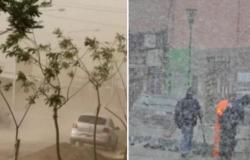22:17
A 17th century galleon carrying silver from Bolivia will be refloated off the coast of Spain in an operation considered “unprecedented” in the country and which will cost 650,000 euros.
The Port Authority of the Bay of Cádiz, in the south of Spain, reported this Wednesday (04/24/2024) that it will finance the operation with which it is expected that in a period of three months it will be possible to name the ship and clarify its route. It is believed that he was making some type of commercial trip from America.
This galleon, Temporarily identified as Delta 1, it was discovered in 2011 in some works in the port of Cádiz and was moved under the sea to a nearby area, so as not to affect the work, in an operation that made it possible to find, among other pieces, 27 cannons Swedish iron, 22 silver ingots from the mines of Oruro and Potosí, in present-day Bolivia, and navigation elements.
The ship is now interfering with other works, so it was agreed that the best solution is “an unprecedented operation in Spain”, as described by the president of the Port Authority, Teófila Martínez, at a press conference in Cádiz.
archaeological research
The ship will be taken out of the sea and placed on a bed of sand, under a tent and in constant humidity to prevent deterioration, so that experts in underwater archeology can document each layer of the wreck, dismantle it in layers and scan the pieces.
The final objective is to “name the ship and determine what route it was taking when it sank,” because this information will allow us to delve deeper into the lesser-known maritime history, which is precisely that of ships built in the 17th century, explained the director of the Center. of Underwater Archeology of Andalusia, Milagros Alzaga.
Although the entire deck of the ship is preserved, when the investigation is completed the galleon will be returned to the seabed and covered with a reversible tank, in case future techniques facilitate its display.
The specialist recalled that to keep the Mary Rose abroad in the United Kingdom, an investment of more than 50 million euros and a wait of more than 34 years was necessary.
What is a galleon, and why were they shipwrecked…
A galleon is a type of sailing vessel that reached its peak in the 16th and 17th centuries. These ships were large and robust, designed for transporting cargo and as warships. Galleons usually had three or four masts and a square sail on each.
Galleon shipwrecks were common in the seventeenth century for several reasons. First, shipping at the time was subject to inclement weather and a lack of modern navigation technology, making voyages inherently dangerous.
In addition, galleons often made long voyages through unknown seas, facing storms, strong winds, and natural hazards such as reefs and sandbanks.
In addition to natural risks, galleons were also prey to pirate attacks and other enemy nations, increasing the likelihood of shipwrecks due to armed conflicts on the high seas.
The combination of these factors made galleon shipwrecks relatively common during the seventeenth century, leaving a fascinating legacy and abundant archaeological remains that are the subject of study and research today.







